Spanish transactions rising, thanks to foreign buyers
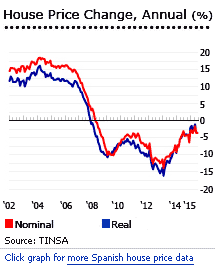 Spain’s housing market continues to recover, amidst continuous improvement in economic conditions. House prices are still falling. But the good news is, property demand has already picked up, thanks to foreign homebuyers.
Spain’s housing market continues to recover, amidst continuous improvement in economic conditions. House prices are still falling. But the good news is, property demand has already picked up, thanks to foreign homebuyers.
Spanish house prices dropped 3.56% during the year to end-June 2015 (-3.56% inflation-adjusted), up from the 3.03% y-o-y decline in May 2014 and almost the same as the 3.57% annual drop seen in the previous month, based on figures from TINSA. Quarter-on-quarter, house prices fell by 0.7% (-2.2% inflation-adjusted) during the latest quarter.
On the other hand, the Bank of Spain released more optimistic house price figures. During the year to end-Q1 2015, Spanish house prices dropped slightly by 0.1% (but increased 0.94% when adjusted for inflation). In a quarterly basis, house prices fell by 0.36% (but rose by 1.35% inflation-adjusted) in Q1 2015.
Spanish house prices have been falling for seven consecutive years, with a total decline of 41.2% (46.5% inflation-adjusted) from the values reached in Q4 2007, before the crisis. There have been 31 consecutive quarters of y-o-y declines:
- In 2008, Spanish house prices fell 8.75% (-10.05% inflation-adjusted)
- In 2009, house prices fell 6.57% (-7.23% inflation-adjusted)
- In 2010, house prices fell 3.85% (-6.67% inflation-adjusted)
- In 2011, house prices fell 8.17% (-10.28% inflation-adjusted)
- In 2012, house prices fell 11.34% (-13.82% inflation-adjusted)
- In 2013, house prices fell 9.19% (-9.44% inflation-adjusted)
- In 2014, house prices fell 2.96% (-1.96% inflation-adjusted)
The national figures conceal regional house price movements. Most regions are showing remarkable improvement while others remain depressed.
During the year to Q2 2015:
- In the Capital and Large Cities, house prices dropped 2.65%, a sharp improvement from annual declines of 4.84% in Q2 2014, 11.55% in Q2 2013, and 13.53% in Q2 2012
- In Metropolitan Areas, house prices dropped 4.88%, from annual declines of 2.96% in Q2 2014, 12.72% in Q2 2013, and 11.64% in Q2 2012
- On the Mediterranean Coast, house prices dropped 3.13%, an improvement from annual declines of 7.16% in Q2 2014, 7.44% in Q2 2013, and 13.33% in Q2 2012
- In Balearic and Canary Islands, house prices rose slightly by 0.15%, up from annual increase of 0.07% in Q2 2014, and in contrast with y-o-y declines of 3.74% in Q2 2013, and 6.78% in Q2 2012
- In Other Municipalities, house prices fell by 5.53%, worse than the y-o-y drop fo just 0.14% in Q2 2014, but an improvement from annual declines of 11.49% in Q2 2013, and 7.36% in Q2 2012
Residential property transactions rose by 17% to a total of 30,578 units in June 2015 from the same period last year, its tenth consecutive month of annual rises, according to the Instituto Nacional de Estadistica (INE). The increase in home sales was mainly driven by the rise in existing home purchases.
This improvement in property transactions is mainly driven by foreign property buyers, buying luxury homes on the coast and in cities like Barcelona and in Costa del Sol, one of the country’s most popular areas with overseas purchasers.
“Buyers are realizing the market has hit rock bottom,” said Rachel Haslam of real estate agency Lucas Fox. “This situation has led to an increase in buying activity but we still have not noticed the increase in prices,” said Damian Pena of Engel and Volkers. “The logical tendency is that the prices will start to rise next year,” he added.
Britons accounted for 15% of all sales to overseas investors, followed by the French (10%), Russians (9%), and Belgians (7%), according to Spain’s society of property registrars. There is also an uptick in interest from U.S. buyers, with the dollar strengthening against the euro.
The total number of foreclosures also fell by 6.5% to 17,786 dwellings in Q1 2015 from the same period last year, based on figures from the INE.
The Spanish property market is expected to continue stabilizing for the remaining months of the year. “With unemployment falling, the economy growing faster than predicted and property reaching the bottom, 2015 is set to be a pivotal year for Spain´s property market. Prices are on average 40% below what they were since the start of the crisis in 2007 and we predict a slow and steady recovery,” said Alexander Vaughan of real estate agency Lucas Fox.
In Q2 2015, the Spanish economy expanded by 3.1% from a year earlier, up from an annual real GDP growth rate of 2.7% in the previous quarter and the biggest expansion since Q4 2007, according to the preliminary data released by the INE. The economy is expected to grow by 3.1% this year and by another 2.5% in 2016, up from a growth of 1.4% last year, and contractions of 1.2% in 2013, 2.1% in 2012 and 0.6% in 2011, according to the Bank of Spain.
Urban land prices skyrocketing in towns
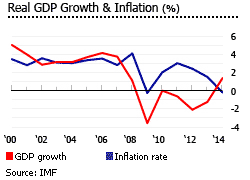
In the first quarter of 2015, urban land prices in Spain rose by 5.9% from the same period last year, to an average of EUR149.9 per square meter (sq. m.), based on figures released by the Ministry of Public Works. This was in contrast with the 3.7% y-o-y decline registered by end-Q4 2014.
In fact, in towns and cities with a population of 50,000 people or more, land prices actually skyrocketed by 37.8% y-o-y in Q1 2015, to an average of EUR304.3 per sq. m.
The highest urban land prices were recorded in Madrid, with an average of EUR 546.2 per sq. m., followed by Barcelona (EUR 448 per sq. m.), and the Balearic Islands (EUR353.1 per sq. m.). In contrast, the lowest land prices were registered in Caceres, with an average of EUR148.8 per sq. m., followed by Pontevedra (EUR 153.3 per sq. m.) and Cantabria (EUR 154.1 per sq. m.).
Land transactions rose by 4.4% to 3,465 units in Q1 2015 from the previous year.
From boom to gloom
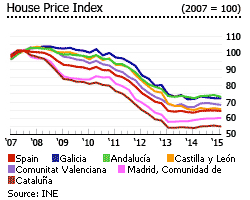
From 1996 to 2007, Spain’s national average house price rose by 197% (117% in real terms), one of Europe’s highest house price increases.
Madrid and Barcelona aside, Spanish house prices are generally highest on the Mediterranean: in Catalona, Andalucia and Valencia. The price of coastal properties surged 250% (155% in real terms) from 1996 to 2007, on average, as hundreds of thousands of foreigners, mainly from the UK, France and Germany, bought property.
The average price of properties in Spain’s two main cities, Madrid and Barcelona, rose 188% (and in real terms?) from 1996 to 2007, while prices in other inner provinces rose by 175% (101%).
The massive housing boom ended abruptly in 2008, as the global crisis hit and credit dried up. The housing slump has battered the Spanish economy, and brought spiralling unemployment. Developers were left with blocks of unsold properties and massive debts. Uncertainty engulfed the market.
By Q1 2015, house prices had fallen by about 30% from the 2007 peak, according to Bank of Spain figures. (Please provide some explanation of why these Bank of Spain figures are so very different from those given in the opening paragraphs)
In the first three months of 2008 the average price of private housing stood at EUR 2,101 (USD) per square meter, compared to March 2015’s EUR 1,458 (USD), which is the second lowest figure registered since the beginning of 2004.
SAREB, Spain’s ‘bad bank’

For several years prior to 2008, the Spanish authorities have failed to monitor uneconomic lending practices and failures associated with the savings banks in Spain. The ease of access and low borrowing costs fuelled the growth of the property and construction sectors of the economy, ultimately leading to a speculative bubble. The initial growth masked the scale of these problems. Soon after, the global credit crunch and the sovereign crisis of the Euro zone ensued, triggering a global recession and leaving creditors with bad debts.
SAREB (Sociedad de Gestión de Activos procedentes de la Reestructuración Bancaria or Company for the Management of Assets proceeding from Restructuring of the Banking System) was founded in 31 August 2012 tasked to separate toxic or problematic assets from the balance sheets of credit institutions that require public support. SAREB is loosely called Spain’s “bad bank”.
Apart from achieving restructuring of the Spanish financial system within a maximum period of 15 years, it also aims to obtain the maximum possible profit earning capacity from these problematic assets.
About EUR 55 billion (USD 75.84 billion) have been transferred to SAREB from nationalized Spanish financial institutions: BFA-Bankia, Catalunya Banc, NGC Banco-Banco Gallego and Banco de Valencia; and banks that have required medium-term financial aid. Of this amount, two thirds correspond to loans and credits associated with the real-estate sector, and a third to real-estate assets.
SAREB, which has 15 years to sell off its assets, has reduced its portfolio down to just over EUR44 billion in 2014. In 2014, its investments in property assets excluding debt climbed to EUR10.4 billion, up from EUR 4.9 billion in 2013, as the Spanish economy improves, according to the CBRE.
SAREB continues to offload assets transferred from the country’s ailing saving banks. It has started placing these assets into portfolios to be sold to investors, which has helped generate confidence that a floor may have been set on prices.
Foreign demand has surged
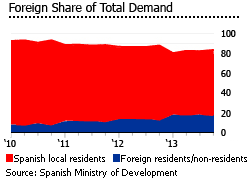
Foreign investors have started to return to the Spanish property market since the crisis hit in 2008. Of the total of 365,342 homes sold in 2014, foreign homebuyers, both residents and non-residents, accounted for 61,062 units or 16.7% of the home sales transactions carried out in Spain, according to the Spanish Ministry of Development. This was the highest percentage of foreign property buyers recorded in a year.
Of the homes acquired by foreign buyers last year, foreign residents in Spain purchased 56,674 homes while the remaining 4,388 homes were acquired by non-resident foreigners. This was the highest number of properties acquired by foreign buyers since 2007 when foreign residents acquired 87,204 homes while non-residents purchased 9,106 homes.
“At the high end — €500,000 and up — it’s primarily being driven by international demand,” says Alex Vaughan of real estate agency Lucas Fox.
The Britons remain the number one buyers in Spain, accounting for about 18.6% of all home purchases by foreigners, followed by the French (9.4%), Germans (7.25%), Belgians (6.9%), Italians (6.1%), Russians (5.8%), Swedes (5.8%), Chinese (4.1%) and Norwegians (3.7%), according to the latest study conducted by TM Grupo Inmobiliario.
The Golden Visa scheme, which came into force and is fully applicable since 30th September 2013, has resulted in increased interest not only from the Middle East but also from Asia and Russia. Under this system, any non-EU national coming to Spain with more than EUR 500,000 (USD689,700) to invest is automatically granted a residency permit.
Since the Golden Visa scheme was introduced in October 2013 to the end of 2014, it attracted 530 applicants, with 490 of them investing at least EUR 500,000 in real property. Most of the applicants were Chinese and Russians. Spain has received more than EUR 700 million in foreign investment as a result of the said scheme.
The Balearic Islands is especially attractive to the foreign market with more than 40% of total demand coming from foreigners. This is followed by the Valencian community with 35% foreign demand; Canarias with 34%; and Murcia with 24%.
“We see 2015 as the recovery year for the Spanish prime residential property market, driven mainly by increasing numbers of overseas buyers. We expect that those who were deterred by falling prices during the past seven years or so, will enter the market, enticed by some real opportunities,” explained Vaughan.
Transactions rising again
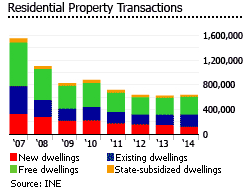
In 2014, the total number of home sales in Spain increased 2.2% to 319,389 units from the previous year, according to the INE. This was mainly due to a surge in sales of second-hand dwellings, rising by 18.4% y-o-y in 2014, to 199,943 units. However, it was weighed down by a decline in new dwelling sales of about 16.9% over the same period, to 119,446 units.
In June 2015, homes sales in Spain rose by 17% from the same period last year. Andalucia accounted for about 20% of all home sales in Spain in June 2015, followed by Valencian Community, 15.2%, Madrid, 14.3%, and Cataluña, 14.1%.
About 90% of the home sales recorded in June 2015 were free housing, i.e., non-subsidized dwellings, according to El Economista.
This bar-chart confused me actually. Not clear to me what a "free dwelling" really is. It seems to include new dwellings and existing dwellings (because the text in the paragraphs above the graph says: "About 90% of the home sales recorded in June 2015 were free housing"), but then why is there is green space between all new and existing dwellings and the subsidized dwellings?
Spanish interest rates are amazingly low
The great Spanish housing boom was fuelled by 15 years of dramatic reductions in mortgage interest rates, from 17% in 1991, to 10%–12% (1995 to 1996), to below 3.5% (2004 – 2005) - among the lowest rates in Europe.
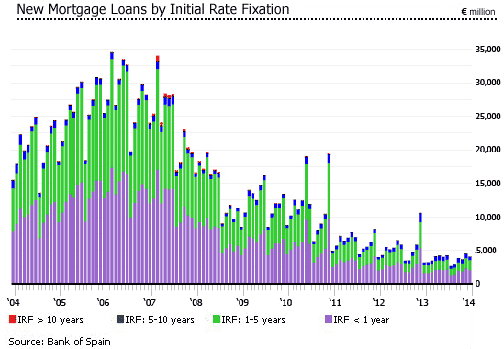
Post-crisis, the average mortgage interest rate in Spain has stabilized at between 2.3% and 3.0% since the second half of 2009, after the European Central Bank (ECB) cut rates in response to the financial crisis to as low as 1% in May 2009, where they have remained until March 2011.
When the ECB raised the key rates by 25 basis points to 1.25% in April 2011 and to 1.5% in July 2011, the average mortgage rate followed, reaching to 3.12% in December 2011.

Spain’s housing market is extremely vulnerable to interest rate changes, due to the use of adjustable rate mortgages. More than 80% of new mortgages have had initial rate fixations (IRF) of less than 1 year since 2004 (more than 90% of new loans from 2005 to 2006). In 2010, about 86% of new mortgage loans had an IRF of less than a year; in 2011, about 82%; in 2012, about 78%; and recently, it has moderated to around 68%.
Following ECB rate reductions, the average mortgage rate in Spain dropped to 2.61% in December 2012, to 2.11% in December 2013 and to 1.89% in December 2014. The ECB key rates were slashed several times to a historic low of 0.05% in September 2014 where they remained until now.
In June 2015, the average mortgage rate in Spain stood at 1.7%.
- The interest rate for housing loans with initial rate fixation (IRF) of up to 1 year stood at 4.57%, down from 5.48% a year earlier
- The interest rate for housing loans with IRF between 1 and 5 years was 6.1%, down from 6.31% a year earlier
- The interest rate for loans with IRF of over 5 years was 1.69%, down from 2.12% a year earlier.
The mortgage market has shrunk, but new mortgages are rising
The size of the mortgage market contracted to about 55% of GDP in 2014, down from 57.8% in 2013, 60.2% in 2012 and 61.3% in 2011, based on figures released by the European Central Bank (ECB).
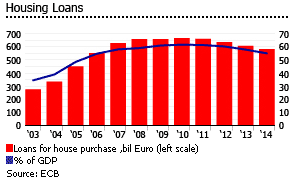
In 2014, the total amount of mortgage loans outstanding in Spain dropped 4.1% y-o-y to EUR581.7 billion. Then in June 2015, mortgage loans outstanding fell by another 4.8% to EUR565.8 billion from the same period last year.
Although a total of 319,389 homes were sold in Spain in 2014, only 202,927 new mortgages on homes were recorded, according to the National Statistics Institute. This suggests that almost 36.5% of the home purchases were transacted in cash last year.
Since the peak levels of 2006, when 1,342,171 new home mortgages were constituted, the figure has fallen by 85%. In 2014, the number of new home mortgages increased 1.6%, an improvement from annual declines of 27.8% in 2013, 33% in 2012, 32.8% in 2011, 6.7% in 2010, 22% in 2009, 32% in 2008 and 6.7% in 2007.
During the first five months of 2015, the number of new home mortgages rose by 20.1% to 100,606 loans compared to the same period last year.
Rents falling, yields recovering
Since prices peaked in May 2007 at EUR 10.12 (USD 13.96) per sq.m. per month, the price of rental housing has accumulated a decline of about 32% by early-2014, according to fotocasa.es data reported by Kyero News. In fact, eight regions have recorded declines of over 30% since they reached their maximum price levels six years ago:
- Aragón is the region to register the biggest drop in rental prices (around -43%)
- Cantabria (around -38%)
- Valencia (around -37%)
- Castilla-La Mancha (around -34%)
- Catalonia and Murcia (around -33%)
- La Rioja (around -31%)
- Andalusia (around -30%).

Prices per square metre (sq. m.) of apartments in Barcelona range from around EUR 3,300 to EUR 4,100, according to a Global Property Guide research conducted in July 2014. In the heart of Madrid, i.e., Chamartín, Chamberí, Retiro and Salamanca, prices per sq. m. range from around EUR 3,400 to EUR 3,800. In nearby upscale suburbs of Madrid such as Las Rozas, Majadahonda and Pozuelo de Alarcón, apartments are cheaper, with prices per sq. m. ranging from around EUR 2,600 to EUR 2,700.
The centre of Madrid fetches the highest rents per sq. m. Apartments here cost around EUR 11 to EUR to EUR 14 per sq. m. to rent per month or the equivalent monthly rental income of around EUR 970 for a 75-sq. m. apartment.
Apartments in the suburbs of Madrid cost around EUR 9 to EUR 11 per sq. m. to rent per month or the equivalent monthly rental income of around EUR 1,100 for a 120-sq. m. apartment to around EUR 2,300 for a 250-sq. m. apartment.
In Barcelona, rents per sq. m. per month range from around EUR 11 to EUR 14 or the equivalent monthly rental income of around EUR 950 for a 85-sq. m. apartment, to around EUR 2,300 for a 200-sq. m. apartment.
Gross rental yields on property in Spain are slowly recovering. They are still not high enough to make buying an apartment attractive from the yields perspective, but they are a little better than they were previously.
The gross rental yield for apartments in Barcelona ranges from 3.80% to 4.70%, whereas in the centre of Madrid, rental yields are better, ranging from 3.91% to 4.92%. In Madrid-suburbs, rental yields range from 4.11% to 4.87%.
Housing glut expected to clear by 2017

The supply and demand gap in the housing market has been widening for the last five years. The total housing stock stood at 25.3 million dwellings by the end of 2012, of which around 700,000 new dwellings are still unsold, according to Souheir Asba, an analyst at Societe Generale, in a report by International Business Times. The oversupply of homes reached its peak in 2010, when the surplus stock amounted to 931,615 homes, according to the Institute of Business Practices (el Instituto de Práctica Empresarial or IPE). Then in 2014, the surplus of homes fell by 14.7% y-o-y to 662,761 homes.
Valencia accounted for about 25% of the total surplus homes in the country. The region, which is heavily influenced by coastal second homes, had a total stock of 163,098 units by end-2014. The housing stock in Valencia is expected to drop to 27.5% this year, according to MAR Real Estate and IPE. Castilla-La Mancha, which had the country’s second biggest stock of surplus homes, is expected to have 72,944 units by end-2015, down by 13.6% from the previous year. Andalucia came next, with 59,563 housing units expected this year, down by 41% from a year earlier. Castilla-La Mancha and Andalucia accounted for about 30% of Spain’s housing oversupply.
The degree of overbuilding can be guessed at by looking at the number of housing starts from the National Statistics Institute (INE):
- From 1990 to 1996, an average of 240,000 dwellings were started annually.
- Between 1999 and 2002, with house prices rising rapidly, dwelling starts exceeded 500,000 units annually. The number rose to more than 650,000 annually from 2003 – 2004
- In 2005, dwelling starts exceeded 700,000 and peaked at 760,179 in 2006, due to rising demand from EU nationals
- In 2007 commodity price rises brought rising costs – and starts slowed to 615,976.
- The global financial meltdown brought drastic decline. There were just 328,500 dwelling units started in 2008, dropping to 159,286 units in 2009. By the end of 2010, there were about 123,616 dwelling starts in Spain
- Dwelling starts declined further in 2011 to only 86,252. By 2012, only about 50,000 housing starts were registered.
- Dwelling completions followed a similar path. Despite the massive oversupply, dwelling completions exceeded 630,000 in 2008, most units having been started before the crisis. In 2009, dwelling completions dropped to 424,000. In 2010, completed dwellings stood at 276,883. A further decline in 2011 with only 179,351 dwellings completed. Only 133,415 dwellings were completed in 2012.
In 2014, licenses to build residential buildings fell by 8.5% y-o-y to 14,878 units, its eight consecutive years of annual declines, based on figures from INE. This was in sharp contrast with the annual average of more than 150,000 licenses issued from 1998 to 2007.
Tinsa believes the housing glut will be cleared by 2017 and new constructions will have to pick up by second half of 2015.
Spain’s long-awaited economic recovery
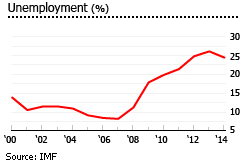
Spain’s economy started to recover in 2014, with real GDP expanding by 1.4%, based on figures from the International Monetary Fund (IMF). In fact in January 23, 2014, Spain became the second euro zone country to exit its international bailout program, after Ireland. In Q2 2015, the Spanish economy expanded by 3.1% from a year earlier, up from an annual real GDP growth rate of 2.7% in the previous quarter and the biggest expansion since Q4 2007, according to the preliminary data released by the INE.
It has been a long, hard slog. Recession has been Spain’s normal condition for years. In 2013, the economy shrank by 1.2%, according to the IMF, and by 1.6% in 2012. In 2011, the economy grew 0.5%, but there were annual declines of 0.2% in 2010, and 3.8% in 2009.
The economy is expected to grow by 3.1% this year and by another 2.5% in 2016, up from a growth of 1.4% last year, and contractions of 1.2% in 2013, 2.1% in 2012 and 0.6% in 2011, according to the Bank of Spain.
Spain’s economy was fuelled by property during the boom decade from 1997 to 2007, when it grew by 3.8% each year. The building frenzy spread to all parts of Spain and ignited a crazy optimism, supported by cheap mortgage credit and by an unbelievable surge in residential construction. At the height of the housing boom in 2007, housing investment was no less than 7.5% of Spain’s GDP, significantly above the OECD average. The construction industry became a key employer of low-skilled workers. The increase in construction activity helped pull unemployment down from 24% in 1994, to 8.3% in 2007. Then the economy plunged into recession in late 2008 and had been down for several years since then.
With the situation reversed, Spanish unemployment now stands at 22.5% in June 2015, down from 24.5% from the previous year but still among the highest in the OECD and more than twice the euro area average of 11.1%. There were about 4.23 million unemployed persons in Spain in June 2015. The country’s overall unemployment rate is expected to fall further to 21.1% at the end of 2015, according to government estimates.
In June 2015, Spain’s inflation was 0%, unchanged from a year ago but up from 11 consecutive months of falling consumer prices, according to INE. The country’s inflation rate is expected at -0.6% this year and 1.1% next year, according to the European Commission.
Spain narrowed its budget deficit last year to 5.8% of GDP, significantly down from 7% in 2013 but remained the second highest deficit (by percentage of GDP) in the EU, behind Cyprus, according to Eurostat. The deficit is projected to fall to 4.5% of GDP next year and to 3.5% 0f GDP in 2016.
Spain’s overall debt reached more than EUR1 trillion last year – about 97.7% of GDP. It is expected to increase further to 100.4% of GDP this year and to 101.4% of GDP in 2016.